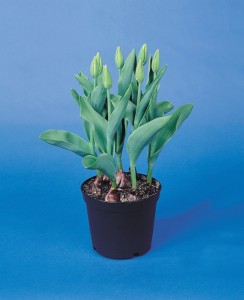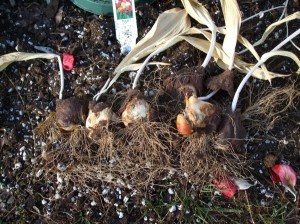
Tulips forced into bloom can be transplanted to the ground is spring. Photo courtesy www.bulb.com
A reader received a pot of five tulips for Valentine’s Day and “now I would like to know if I can plant these bulbs outside,” writes A.D. of Indianapolis.
You can and here are some tips:
- Allow the foliage of the bulbs to ripen in the pot. The leaves are ripe when they turn yellow and fall flat. Water sparingly during this period.
- Once the foliage has ripened, remove the soil and bulbs from the pot.
- Separate the bulbs and snip off the ripened foliage.
- Plant in full sun and well-drained soil as soon as you can work the soil. Plant three or four times deeper than the bulb is tall. If the bulb is two inches tall, plant it six to eight inches deep.

Separate and plant bulbs after foliage has ripened. (C) Jo Ellen Meyers Sharp
- Water well.
- Next spring, the bulbs should sprout foliage, but they may not flower until the following year. When the bulbs’ leaves break ground in spring, apply an all-purpose granular fertilizer or a dusting of compost.
- This method also works for other hardy, forced bulbs, including daffodils, hyacinths, iris reticulata and crocus.
Spring freezes
Most Hoosiers know that spring temperatures can take a sudden dip into the 20s or below, which may threaten the flowers of our bulbs, perennials, trees and shrubs.
If you feel you must cover your spring plants to protect them from a hard freeze, use cloth or paper. Protect plants only at night, removing the covering during the day.
If you use plastic, make sure it does not touch the plants. Rather, elevate the plastic like a tent above them. Moisture stays under the plastic and can freeze where it touches the plant, damaging the flowers or leaves you are trying to protect.
I just bought indoor tulip plants which are going to bud very soon. Can this plant be planted outdoors in the spring?